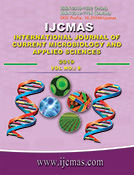


 National Academy of Agricultural Sciences (NAAS)
National Academy of Agricultural Sciences (NAAS)

|
PRINT ISSN : 2319-7692
Online ISSN : 2319-7706 Issues : 12 per year Publisher : Excellent Publishers Email : editorijcmas@gmail.com / submit@ijcmas.com Editor-in-chief: Dr.M.Prakash Index Copernicus ICV 2018: 95.39 NAAS RATING 2020: 5.38 |
Major rice-wheat growing soils of Upper Gangetic Plains, India were studied and evaluated by considering soil-site characteristics by using qualitative and quantitative methods. The qualitative method employed were USDA land capability classification and land suitability classification, while the quantitative evaluation method includes Riquier's parametric approach. The land evaluation methods indicated that information on production potential of soils provide a basis for comparison among different soils. The representative soils of Jalandhar district of Punjab, India were studied and classified into land capability classes IIs, IIIse/sw, IVse, and VIes. However, the land suitability evaluation suggested that majority of these rice-wheat growing soils were suitable to moderately suitable (S1-S2) suitable for wheat while moderately to marginally suitable for rice crop. Soils of active flood plains and recent flood plains are presently not suitable for rice crops. Riquier's parametric approach was found to be good indicator for identification of production potentials of rice-wheat growing soils. The land evaluation study revealed that, soil characteristics and suitability of these soils were highly variable, hence their management must be site and location specific. Soil management strategies based on integrated nutrient management, organic manures, nutrient recycling, mulching, crop residue, crop rotation and inter cropping not only helps to conserve soil and water more effectively in rice-wheat growing soils but also increase organic matter content and improve fertilizer use efficiency. Adoption of suitable soil and water conservation measures and alternate land use not only improves the yields and soil productivity but also sustains the soil health and natural resources.
 |
 |
 |
 |
 |